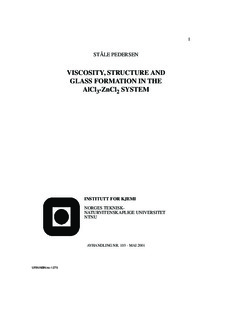| dc.contributor.author | Pedersen, Ståle | nb_NO |
| dc.date.accessioned | 2014-12-19T13:20:40Z | |
| dc.date.available | 2014-12-19T13:20:40Z | |
| dc.date.created | 2001-06-22 | nb_NO |
| dc.date.issued | 2001 | nb_NO |
| dc.identifier | 126161 | nb_NO |
| dc.identifier.isbn | 82-471-5297-5 | nb_NO |
| dc.identifier.uri | http://hdl.handle.net/11250/247466 | |
| dc.description.abstract | Thermodynamic, viscous and structural properties of melts and glasses in the AlCl3-ZnCl2 system have been investigated. The two pure components are fundamentally different in the molten state. Both metal atoms are four coordinated, however, ZnCl2 forms a corner sharing tetrahedral network whereas AlCl3 is a dimer, Al2Cl6. ZnCl2 is one of two known single component halide glass formers and additions of AlCl3 have shown to form stable glasses. The glass forming ability remains far into the binary AlCl3-ZnCl2 system.
The phase diagram of the AlCl3-ZnCl2 system has been investigated by differential thermal analysis. The system is a simple eutectic system, and the eutectic point was observed at 116±2°C and 0.52±0.05 mole fraction ZnCl2. The system is highly glass forming in the range from pure ZnCl2 up to about 0.46 mole fraction ZnCl2. Glass transition temperatures measured by differential scanning calorimetry (heating rate 10 K/min) were recorded from 115°C for pure ZnCl2 to -5.5°C for 0.46 mole fraction ZnCl2. The reduced width of the glass transition ( Tg'-Tg )/Tg showed a maximum at 0.80 mole fraction ZnCl2 giving a minimum in fragility at this composition.
The density of AlCl3-ZnCl2 melts has been determined using volume measurements in sealed quartz tubes. The molar volumes showed a negative deviation from ideality with a minimum at ~0.33 mole fraction ZnCl2 (ZnAl2Cl8). The volume expansion coefficient is strongly reduced from pure AlCl3 to ZnCl2, and the excess volume of mixing is strongly increasing with temperature. A simple model using molecular Al2Cl6, ZnCl2 and ZnAl2Cl8 units was used to calculate equilibrium constants for the reaction of pure components ZnCl2 and Al2Cl6 to ZnAl2Cl8. The density data showed that molecular ZnAl2Cl8 became more stable with increasing temperature. The viscosity of molten AlCl3-ZnCl2 in the range from pure ZnCl2 to 0.40 mole fraction ZnCl2 has been measured as a function of temperature by an oscillation cup method. The melts with ZnCl2 content higher than 0.60 mole fraction ZnCl2 exhibited non-Arrhenius behavior. The viscosity clearly decreases with increasing AlCl3 content. However, the viscosity of ZnCl2 is affected less by addition of AlCl3 compared to addition of ionic chlorides which form terminal chloride bonds. The fragility of the melts obtained from a reduced Arrhenius plot, were observed to decrease with addition of AlCl3 up to 0.80 mole fraction ZnCl2. At higher AlCl3 content the fragility increases in line with the more molecular nature of the melt. The present study has also demonstrated that the oscillation cup viscometer can be applied to record viscosities as high as 3 Pa·s.
IR spectroscopy has been performed on melts in the whole compositional range of the AlCl3-ZnCl2 system. The spectra were recorded using an IR reflection method of thin films (>10 µm). Compensation for any splitting of strong bands was performed by defining a specular reflectance, r*, where a thick melt (2-3 mm)\ was used as reference. For all the mixtures a splitting of the anti-symmetric stretching frequency ν3(F2) for the AlCl4 tetrahedron into three bands was observed. This indicated a C2v perturbation of the Td symmetry. From this observation it was proposed that the AlCl4 units were always terminal consisting of two bridging and two terminal chlorines. The melts with compositions from 0.33 mole fraction ZnCl2 to pure Al2Cl6 are proposed to consist of a mixture of Al2Cl6 and ZnAl2Cl8. The temperature dependence of the 0.20 mole fraction ZnCl2 spectra showed that the amount of ZnAl2Cl8 increased relative to the amount of Al2Cl6 with increasing temperature. At 0.40 - 0.60 mole fraction ZnCl2, the melts were proposed to remain molecular in nature, where the ZnCl4 tetrahedra were enclosed by edge sharing AlCl4 terminal units. At higher ZnCl2 content or higher temperatures the connectivity of the molten structure is shifted from edge sharing AlCl4 units to corner sharing AlCl4 units bonded to two ZnCl4 tetrahedra. | nb_NO |
| dc.language | eng | nb_NO |
| dc.publisher | Fakultet for naturvitenskap og teknologi | nb_NO |
| dc.relation.ispartofseries | Dr. ingeniøravhandling, 0809-103X; 2001:36 | nb_NO |
| dc.subject | Inorganic chemistry | en_GB |
| dc.subject | NATURAL SCIENCES: Chemistry: Inorganic chemistry | en_GB |
| dc.title | Viscosity, structure and glass formationin the AlCl3-ZnCl2 system | nb_NO |
| dc.type | Doctoral thesis | nb_NO |
| dc.source.pagenumber | 160 | nb_NO |
| dc.contributor.department | Norges teknisk-naturvitenskapelige universitet, Fakultet for naturvitenskap og teknologi, Institutt for kjemi | nb_NO |
| dc.description.degree | dr.ing. | nb_NO |
| dc.description.degree | dr.ing. | en_GB |
